Jim Hemmingway
Hero Member
- #1
Thread Owner
Electronic Prospecting in Silver Country
Introduction…
A prospecting trip to silver country is an opportunity to enjoy the great outdoors while pursuing your mineralogical interests in lovely rugged settings as depicted in the photo below. I recently enjoyed a highly successful two-month autumn prospecting trip to the area. This particular site is one of my favorites because it is more remote…a great place to detect silver in a quiet, relaxed environment.
You will see some quality recoveries from this trip including a 100+ pound silver and calcite sample that understandably may challenge some readers’ sense of credibility… such finds possibly are outside their experience or awareness. Nonetheless, while we don’t see them everyday, electronic prospectors searching in this area have recovered quite a number of such large pieces over the years. I was fortunate to locate a deposit that yielded not one, but several large museum quality silver specimens.
Many individuals and one mineral club were encountered this year at various sites. A number of these people did not experience much success at finding silver. We will discuss some basic metal detecting techniques and search strategies that should help them to be more successful. Perhaps some of these ideas will interest gold prospectors…please enjoy the read.
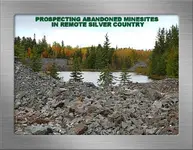
Searching Mining Camps and Surrounding Terrain…
A determined electronic prospector can recover specimen grade silver even at the more accessible mining camps in silver country despite several decades of collecting pressure. There is very good potential for those that do their research, use equipment appropriate to site conditions, and are willing to do some pick and shovel work.
To be effective, prospecting-capable metal detectors are required that can help separate silver from iron trash, non-conductive iron-mineralized hotrocks, and conductive hotrocks such as pyrrhotite. My ground-balancing PI units…the Infinium and TDI Pro have limited but very real ability to separate nails and other elongated high conductive iron from silver, mostly do not respond to non-conductive hotrocks encountered in this area when properly ground-balanced, and achieve good depth in tough ferromagnetic ground minerals. My VLF units…the F75 and MXT achieve respectable depth even in moderately tough ground, and offer the benefits of target ID, discrimination, improved sensitivity to small stuff and to disseminated or spongy ore structures. These units are used for specific tasks as described below, and in the unlikely event that a unit should malfunction there is a capable replacement in the truck.
Ensure your VLF unit can operate in an all-metal motion mode for best depth in tough ground minerals, and can be ground-balanced either manually or using a GROUND GRAB feature as a minimum. The GROUND GRAB is accurate and convenient, and is an additional quick source of information when evaluating questionable signals. It makes searching hotrock areas properly ground-balanced in the all-metal motion mode more feasible because it takes only a moment to check out a suspect hotrock signal and then quickly rebalance to the ground and continue searching. The F75’s GROUND GRAB for example, does not permit ground-balancing below GB40 to prevent locking into metals at more conductive GB settings.
The diabase positive hotrocks encountered at one excavation site this year converted to neutral or slightly negative hotrock signals and lost their target ID when ground-balanced using the GROUND GRAB technique. Silver ores retained a good positive signal, but in the event there is any doubt about a target’s identity…revert to the rule of thumb and dig it. There is more to be said about this technique as to how concentric and DD coils respond to various minerals, for example conductive pyrrhotite, niccolite and other arsenides, rusty iron, and even variable responses from silver ores. But for now we’ll put this subject aside pending further evaluation in the field. This topic is later covered in detail at http://www.treasurenet.com/forums/canada/328287-electronic-prospecting-silver-country-part-2-a.html
Hotrock-level discrimination can be used to eliminate such signals and in some areas it is convenient to do so despite that it is less sensitive and less deepseeking than the all-metal motion mode. But the price is eliminating deeper silver in elevated magnetic susceptible iron mineral ground. The photo below is a prime example of silver that was predominately identified as iron in diabase hotrock environs. But it did not exhibit elongated iron’s typical target ID fluctuations when scanned from different directions, and when ground-balanced it retained a good positive signal with virtually no reduction in the GB readout. It was no positive hotrock and certainly didn’t look to me to be rusty iron. Those who rely on hotrock discrimination, iron audio tones, or exclusively on target ID would and likely did overlook it.
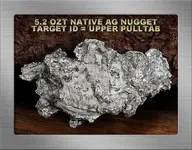
Visual target ID and ground balance readouts using the GROUND GRAB feature on my F75 provide good sources of information in this application, but we should use some judgement. For example, positive diabase hotrocks read consistently in the upper iron range at target ID “14” but as noted…when ground-balanced they lose their positive signal, their target ID disappears, and there is always a small reduction in their ground balance readout. This is because diabase exists within a narrow GB range from GB86 to GB92 on an F75 using a 10” concentric elliptical coil. As a rule diabase is primarily a source of negative hotrocks, but that changes when the substrate is mostly comprised of diabase rocks. Other types of iron oxide hotrocks occupy much wider GB ranges and that also applies to conductive pyrrhotite rocks…hence ground-balancing to these may result in a dramatic GB reduction. The important point is that positive diabase hotrocks…non-conductive iron mineralized hotrocks…lose their positive signal when ground-balanced using the handy GROUND GRAB technique.
Rusted iron may reside at various target ID readings within the iron range, may jump in-and-out of the iron range, or may pretty much reside at various higher conductive readouts. Target ID depends on size and shape, coil sweep direction, state of oxidation and rust deposition into the surrounding soil, depth, and the ground mineral magnetic susceptible strength. That said, small iron normally occupies the iron range and larger iron tends to do otherwise in undisturbed field conditions. Deep large or compact iron is difficult to separate from large silver ore using VLF units until a good portion of the overburden is removed. Rusted iron produces a GB reduction but how much depends on conditions described above. For example, rusty drillrods in-situ can produce a dramatic GB reduction down into the low GB40s on the F75…an additional and valuable piece of information when evaluating target signals.
The photo below depicts a good quality silver specimen found with the F75…all-metal motion mode, bare threshold, near max sensitivity, GB at 86, Fe3O4 at 0.3% EM. This piece is quite heavy for its size. The areas shaded slightly gray indicate massive silver immediately beneath the surface…this rock would benefit from an acid wash to expose more silver.
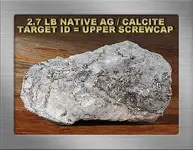
By comparison, silver ores can read anywhere from the iron range to silver dime conductivity. Natural silver can also read in the silver quarter range, but these are so extremely rare as to be of no practical consequence. Whether silver ores target ID in the iron range depends on variables such as target size and depth, the proximity of iron junk, and the substrate’s ferromagnetic susceptible strength. When ground-balanced silver retains a positive signal and target ID, but GB reductions tend to be a bit unpredictable in tough ground and where non-silver inclusions occur in silver ores. Niccolite and cobaltite ores normally produce dramatic GB reductions. If you know you’re searching in even moderately tough ground…remove some material to acquire a stronger signal where necessary…and further evaluate suspect signals by sweeping the coil from different directions. Silver doesn't normally change, but elongated iron target ID usually fluctuates. When evaluating suspect signals consider the target size and shape in addition to strong target ID shifts that result from iron’s conductive and magnetic properties.
Below is a handsome example of ruby silver combined with native silver in a calcite matrix. Ruby silver comes in several forms. These are silver sulfide (sulfosalt) minerals with variable silver content on occasion combined with some minor copper replacement, sulfur, antimony and / or arsenic content. The silver content ranges from roughly 60% to nearly 70% by weight depending on the type of ruby silver. The ruby silver in the photo below is a fresh pyrargyrite surface that extends completely through the rock, whereas the reader’s left-hand side of the rock is comprised of native silver in calcite…a rare and unique specimen.
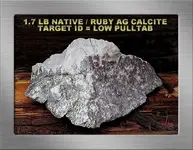
Discrimination is sometimes essential to searching sites so replete with small bits and shards of metallic iron that searching in the all-metal motion mode is just not a viable option. It is better to find some silver in these conditions rather than spend a frustrating day dealing with countless blaring signals from bits of iron wire and small tacks and nails. After all…electronic prospecting is supposed to be rewarding and fun.
Setting discrimination levels in prospecting applications depends on the targets you want to eliminate, and the size and conductivity range of non-ferrous targets you want to find. The most likely procedure is to bury a few representative targets at reasonable depths and determine what control settings will get the job done to your satisfaction. Over highly mineralized substrates, target ID and discrimination will not work reliably and detection depth markedly suffers. Good silver can read as iron even at modest depths. In such environs if you want to get it all…you will have to dig it all…but this modus operandi is an instructive, eye-opening experience. Wherever possible stick with the all-metal motion mode and use both the target ID and GROUNDGRAB features to advantage, in addition to removing overburden until you are satisfied about a target’s identity.
The photo below depicts a quality silver ore found at good depth…an Infinium hi-lo zero discrimination signal. This specimen is very heavy for its size and the native silver is quite pure. Although the specimen appears to be structured as a mass of veinlets…that is surface appearance only, as such do not account for the weight or a conductive readout in the zinc penny range.
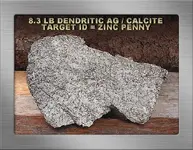
For general field searching of specimen quality silver and ore pockets, I normally use a ground-balancing PI unit and reasonably large coil for maximum depth and coverage where trash levels are tolerable. Both my TDI Pro and Infinium are able to separate some iron trash from native silver…a real work and timesaver…but do it differently.
However, neither unit can separate low conductive iron signals from low conductive silver signals. But they do achieve better depth in tough ground than VLF units, and aside from conductive pyrrhotite, they mostly do not respond to non-conductive hotrocks in this area when ground-balanced to normally encountered ground mineral conditions. More information about these units for this application can be accessed on this forum at http://www.treasurenet.com/forums/c...ntry-infinium-comparison-february-2011-a.html and more specifically about the Garrett Infinium at http://www.treasurenet.com/forums/c...erfields-ontario-revised-february-2011-a.html . These files are in storage on the Canada sub-forum for reference / convenience.
Many areas are littered with iron and other trash such that “masking” of good silver occurs. Search these sites with smaller coils using a very slow PI sweep speed for reasonably good target separation while still achieving respectable depths. The TDI Pro excels at this task…particularly using the low conductive tone mode while properly ground-balanced at GB9ish in these parts. By and large with these settings, it will ignore nails and other high conductive iron insofar as these will not generate repeatable two-way signals. If ground minerals are not excessive, a prospecting-capable VLF unit with iron target ID capability in the all-metal motion mode is a good alternative…especially since small nails and other iron tidbits target ID in the low conductive iron category on VLF units.
Once potentially productive ground is located that warrants excavation, many prefer to use a VLF unit. VLF units offer the benefits described above, and give you a good “feel” for ground minerals and associated anomalies that sometimes result in detecting weak disseminated, or sponge silver signals. This normally involves a lot of pick and shovel work to move and scan material, and VLF depth is more than sufficient for this job. Below is the first notably large piece found this year. I neglected to put in a quarter for perspective but should mention this piece has a length of about 13½ inches.
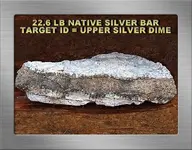
Suggestions for General Searching…
I increasingly tend towards a search strategy that might loosely be described as “pocket” hunting. Over tailings this might more aptly be described as locating spills or unintentional deposits of good material. This strategy accounts for much of my success searching mining camps in recent times.
Locate such deposits by searching sites most likely to have experienced unintentional dumping of good material. That means areas where valuable silver was handled and transported. Look for indications of surface veins, shafts, and storage areas where silver was graded, moved, and sometimes inadvertently misplaced. There is ample research information that can be accessed with modern computers, aside from local historical archives. Photos or drawings are sometimes available that show original building sites and other facilities at many of the now abandoned mining camps in this area. These are especially helpful to pinpoint areas where you may wish to focus your detecting efforts.
When a deposit is indicated, for example by multiple silver signals concentrated in a specific area…or visually as described below…do not be content to merely recover what are essentially surface signals and move on. You may well be standing over a good deposit that could extend down for several feet. Sample by removing some surface material and carefully recheck the excavation for signals. If there are no signals it doesn't hurt to repeat this step…yes it is hard work but well worthwhile if paydirt is located. I can’t emphasize enough to take your time with this job and be thorough. Below is a fine example of typical quality silver ore recovered from the excavation site portrayed below.
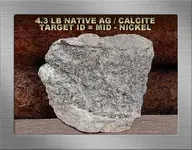
Some potentially good sites have scattered concentrations of small calcite samples on the surface, some containing a tiny thin vein or two of silver. These may well indicate better pickings below but tend to be overlooked by hobbyists using any form of VLF discrimination. Over such ground you are unlikely to find anything worthwhile for the first foot down. Good “detectable” pieces in the top foot likely have already been removed. If a site has potential you will tap into it below that layer. Again, remove some material and scan with either a ground-balancing PI unit set to minimum pulse delay with a smaller coil more sensitive to disseminated or spongy ores…or preferably use a properly ground-balanced VLF unit operated in the all-metal motion mode.
Admittedly this is not an easy task…particularly for the novice electronic prospector. Intensive detecting and collecting pressure for 40 years has removed most of the easily found surface indicator signals at most readily accessible sites. But if you happen across such spots…make an effort to investigate. Sometimes we forget lessons learned when searching for non-metalliferous minerals where our primary search tools are a pick, shovel and screen. In concert with a metal detector these tools can do wonders in silver country. The photo below illustrates that I do exactly what I suggest you do at potentially good sites.
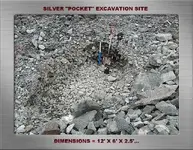
As a result of misgrading ores, good silver was occasionally dumped as waste rock on to
the tailing piles as occurred at the site in the above photo. Tailings may occupy enormously large tracts that snake off into the bush. Some of these have been encroached upon by forest cover and are no longer visible from roadways or mining camps. These mine tailings were used to build local roads, storage beds, entrances into mine sites, loading ramps, and routes to facilitate waste rock transport from the mine to the tailings waste disposal areas. These are excellent prospects to investigate with a suitable metal detector.
The handsome silver ore below is another typical quality piece found at the above excavation site this past autumn. It is rich with native silver…but isn't terribly photogenic. Many such ores ranging between a few ounces and several pounds were recovered at that site…a very productive deposit and certainly worth the time and effort required to sample and excavate.
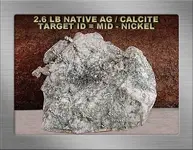
The large specimen below was recovered from a well-drained area not too far distant from a locally acknowledged source of silver floats. Glaciers stripped material from native silver veins and deposited that material in float trains. Some floats appear to be inexplicably distributed at random throughout the area like so much flotsam and jetsam. Scattered silver ores right on the surface have been recovered over many decades dating back to the area’s pioneer days. Electronic prospectors have enjoyed good success at locating various floats…occasionally museum quality finds. All floats are not native silver but commonly are comprised of other minerals, for example cobalt and various arsenides. Searching the outback is all too often rewarded with digging abundant manmade junk, some now residing at good depth.
I didn't anticipate finding such a large piece and almost passed over the signal thinking it would be buried trash. Finding it gave me an exciting few moments, but it was terribly frustrating trying to get this piece out of the bush, and such a relief to finally get it safely into my truck. It was cleaned with a rotary tool and diamond bit that removes all surface silver flakes and horns except the most sturdy. For perspective a silver quarter is placed on the top left side about halfway back.
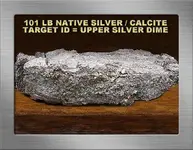
The ‘close-up’ photo below takes a better look at the silver detail unavailable in the above photo due to the sample to camera distance…by using the camera’s optical zoom feature. The rock is inundated with thick coarse silver that protrudes from almost an inch on down to the tiniest veinlets and horns. The vein material travels completely through and around the rock. Other than one narrow section on the reverse side, there is nowhere to place your finger without it resting on silver. Checking it with a multimeter, there are no pair of silver contacts on this rock that are not electrically connected.
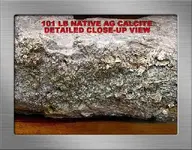
Lets close this section with a few more suggestions that may improve our chances at successfully searching abandoned mine tailings or pursuing silver float deposits in the outback…
Metal detectors are our main tools to locate precious metals, so ensure you know how to use your unit before arriving on site. If you are uncertain about your detector’s control settings over unfamiliar ground…take a few moments to bury some targets and adjust the detector controls to see what delivers the best results. These few moments checking your detector over unfamiliar ground are the best spent moments of your trip.
Research information about whether surface vein materials were exposed to glacial action. With this information we can pinpoint areas that should offer realistic silver float hunting opportunities.
Valuable silver ores were transported with wagons or carts and oxen. Occasional breakdowns resulted in spills and some silver doubtless remained right where it fell. Today’s roads are not necessarily the routes used by yesteryear’s carts loaded with highgrade silver. Compare topographical maps and historical documents…investigate some of those now overgrown and abandoned tracks…they are prime locations to search.
Searching in the later autumn when the leaves are mostly down enhances our ability to
navigate the bush and normally there are no bugs. We can at least see natural features and those created by mining operations that otherwise may be cloaked by foliage. Also there are safety advantages in bear country.
Exploration and sampling is essential to locating new potential sites. I put aside a week or two each season for this purpose alone. One result is that we always have alternate sites if our primary site disappoints.
Below is another of several large silver specimens recovered this trip. The silver shows very well on all sides and on the bottom although the photo depicts the best-looking face. There is no doubt that many more such pieces are just waiting to be found in the outback by an enterprising electronic prospector, and you can bet dimes to doughnuts we are going to see about that next autumn.
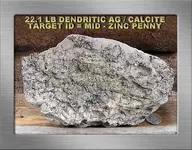
Closing Remarks…
The silver specimen depicted in the photo below exemplifies the quality and typical size of silver ores comprising the bulk of the material recovered this past autumn. It won’t give you bragging rights but its good quality material. The success enjoyed this year was based on the 2010 season. Last year focused on exploration and sampling while evaluating the TDI Pro, whereas this season was largely spent exploiting the results of that work.
Far more time was spent laboring with a pick and shovel than operating a metal detector this season. It is not glamorous or adventurous, but is hard work that may not appeal to many electronic prospecting hobbyists. Yet if potentially good ground is to be evaluated or good silver to be recovered as described earlier, for individual hobbyists that means making generous use of a pick and shovel.
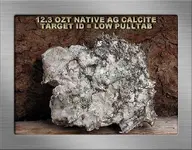
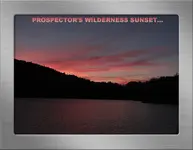
That’s it…other than to thank everyone for spending some time here. Comments are welcome. For newcomers to the hobby… no question is awkward or foolish… so don’t hesitate to ask it.
Jim Hemmingway
February 2012
Introduction…
A prospecting trip to silver country is an opportunity to enjoy the great outdoors while pursuing your mineralogical interests in lovely rugged settings as depicted in the photo below. I recently enjoyed a highly successful two-month autumn prospecting trip to the area. This particular site is one of my favorites because it is more remote…a great place to detect silver in a quiet, relaxed environment.
You will see some quality recoveries from this trip including a 100+ pound silver and calcite sample that understandably may challenge some readers’ sense of credibility… such finds possibly are outside their experience or awareness. Nonetheless, while we don’t see them everyday, electronic prospectors searching in this area have recovered quite a number of such large pieces over the years. I was fortunate to locate a deposit that yielded not one, but several large museum quality silver specimens.
Many individuals and one mineral club were encountered this year at various sites. A number of these people did not experience much success at finding silver. We will discuss some basic metal detecting techniques and search strategies that should help them to be more successful. Perhaps some of these ideas will interest gold prospectors…please enjoy the read.

Searching Mining Camps and Surrounding Terrain…
A determined electronic prospector can recover specimen grade silver even at the more accessible mining camps in silver country despite several decades of collecting pressure. There is very good potential for those that do their research, use equipment appropriate to site conditions, and are willing to do some pick and shovel work.
To be effective, prospecting-capable metal detectors are required that can help separate silver from iron trash, non-conductive iron-mineralized hotrocks, and conductive hotrocks such as pyrrhotite. My ground-balancing PI units…the Infinium and TDI Pro have limited but very real ability to separate nails and other elongated high conductive iron from silver, mostly do not respond to non-conductive hotrocks encountered in this area when properly ground-balanced, and achieve good depth in tough ferromagnetic ground minerals. My VLF units…the F75 and MXT achieve respectable depth even in moderately tough ground, and offer the benefits of target ID, discrimination, improved sensitivity to small stuff and to disseminated or spongy ore structures. These units are used for specific tasks as described below, and in the unlikely event that a unit should malfunction there is a capable replacement in the truck.
Ensure your VLF unit can operate in an all-metal motion mode for best depth in tough ground minerals, and can be ground-balanced either manually or using a GROUND GRAB feature as a minimum. The GROUND GRAB is accurate and convenient, and is an additional quick source of information when evaluating questionable signals. It makes searching hotrock areas properly ground-balanced in the all-metal motion mode more feasible because it takes only a moment to check out a suspect hotrock signal and then quickly rebalance to the ground and continue searching. The F75’s GROUND GRAB for example, does not permit ground-balancing below GB40 to prevent locking into metals at more conductive GB settings.
The diabase positive hotrocks encountered at one excavation site this year converted to neutral or slightly negative hotrock signals and lost their target ID when ground-balanced using the GROUND GRAB technique. Silver ores retained a good positive signal, but in the event there is any doubt about a target’s identity…revert to the rule of thumb and dig it. There is more to be said about this technique as to how concentric and DD coils respond to various minerals, for example conductive pyrrhotite, niccolite and other arsenides, rusty iron, and even variable responses from silver ores. But for now we’ll put this subject aside pending further evaluation in the field. This topic is later covered in detail at http://www.treasurenet.com/forums/canada/328287-electronic-prospecting-silver-country-part-2-a.html
Hotrock-level discrimination can be used to eliminate such signals and in some areas it is convenient to do so despite that it is less sensitive and less deepseeking than the all-metal motion mode. But the price is eliminating deeper silver in elevated magnetic susceptible iron mineral ground. The photo below is a prime example of silver that was predominately identified as iron in diabase hotrock environs. But it did not exhibit elongated iron’s typical target ID fluctuations when scanned from different directions, and when ground-balanced it retained a good positive signal with virtually no reduction in the GB readout. It was no positive hotrock and certainly didn’t look to me to be rusty iron. Those who rely on hotrock discrimination, iron audio tones, or exclusively on target ID would and likely did overlook it.

Visual target ID and ground balance readouts using the GROUND GRAB feature on my F75 provide good sources of information in this application, but we should use some judgement. For example, positive diabase hotrocks read consistently in the upper iron range at target ID “14” but as noted…when ground-balanced they lose their positive signal, their target ID disappears, and there is always a small reduction in their ground balance readout. This is because diabase exists within a narrow GB range from GB86 to GB92 on an F75 using a 10” concentric elliptical coil. As a rule diabase is primarily a source of negative hotrocks, but that changes when the substrate is mostly comprised of diabase rocks. Other types of iron oxide hotrocks occupy much wider GB ranges and that also applies to conductive pyrrhotite rocks…hence ground-balancing to these may result in a dramatic GB reduction. The important point is that positive diabase hotrocks…non-conductive iron mineralized hotrocks…lose their positive signal when ground-balanced using the handy GROUND GRAB technique.
Rusted iron may reside at various target ID readings within the iron range, may jump in-and-out of the iron range, or may pretty much reside at various higher conductive readouts. Target ID depends on size and shape, coil sweep direction, state of oxidation and rust deposition into the surrounding soil, depth, and the ground mineral magnetic susceptible strength. That said, small iron normally occupies the iron range and larger iron tends to do otherwise in undisturbed field conditions. Deep large or compact iron is difficult to separate from large silver ore using VLF units until a good portion of the overburden is removed. Rusted iron produces a GB reduction but how much depends on conditions described above. For example, rusty drillrods in-situ can produce a dramatic GB reduction down into the low GB40s on the F75…an additional and valuable piece of information when evaluating target signals.
The photo below depicts a good quality silver specimen found with the F75…all-metal motion mode, bare threshold, near max sensitivity, GB at 86, Fe3O4 at 0.3% EM. This piece is quite heavy for its size. The areas shaded slightly gray indicate massive silver immediately beneath the surface…this rock would benefit from an acid wash to expose more silver.

By comparison, silver ores can read anywhere from the iron range to silver dime conductivity. Natural silver can also read in the silver quarter range, but these are so extremely rare as to be of no practical consequence. Whether silver ores target ID in the iron range depends on variables such as target size and depth, the proximity of iron junk, and the substrate’s ferromagnetic susceptible strength. When ground-balanced silver retains a positive signal and target ID, but GB reductions tend to be a bit unpredictable in tough ground and where non-silver inclusions occur in silver ores. Niccolite and cobaltite ores normally produce dramatic GB reductions. If you know you’re searching in even moderately tough ground…remove some material to acquire a stronger signal where necessary…and further evaluate suspect signals by sweeping the coil from different directions. Silver doesn't normally change, but elongated iron target ID usually fluctuates. When evaluating suspect signals consider the target size and shape in addition to strong target ID shifts that result from iron’s conductive and magnetic properties.
Below is a handsome example of ruby silver combined with native silver in a calcite matrix. Ruby silver comes in several forms. These are silver sulfide (sulfosalt) minerals with variable silver content on occasion combined with some minor copper replacement, sulfur, antimony and / or arsenic content. The silver content ranges from roughly 60% to nearly 70% by weight depending on the type of ruby silver. The ruby silver in the photo below is a fresh pyrargyrite surface that extends completely through the rock, whereas the reader’s left-hand side of the rock is comprised of native silver in calcite…a rare and unique specimen.

Discrimination is sometimes essential to searching sites so replete with small bits and shards of metallic iron that searching in the all-metal motion mode is just not a viable option. It is better to find some silver in these conditions rather than spend a frustrating day dealing with countless blaring signals from bits of iron wire and small tacks and nails. After all…electronic prospecting is supposed to be rewarding and fun.
Setting discrimination levels in prospecting applications depends on the targets you want to eliminate, and the size and conductivity range of non-ferrous targets you want to find. The most likely procedure is to bury a few representative targets at reasonable depths and determine what control settings will get the job done to your satisfaction. Over highly mineralized substrates, target ID and discrimination will not work reliably and detection depth markedly suffers. Good silver can read as iron even at modest depths. In such environs if you want to get it all…you will have to dig it all…but this modus operandi is an instructive, eye-opening experience. Wherever possible stick with the all-metal motion mode and use both the target ID and GROUNDGRAB features to advantage, in addition to removing overburden until you are satisfied about a target’s identity.
The photo below depicts a quality silver ore found at good depth…an Infinium hi-lo zero discrimination signal. This specimen is very heavy for its size and the native silver is quite pure. Although the specimen appears to be structured as a mass of veinlets…that is surface appearance only, as such do not account for the weight or a conductive readout in the zinc penny range.

For general field searching of specimen quality silver and ore pockets, I normally use a ground-balancing PI unit and reasonably large coil for maximum depth and coverage where trash levels are tolerable. Both my TDI Pro and Infinium are able to separate some iron trash from native silver…a real work and timesaver…but do it differently.
However, neither unit can separate low conductive iron signals from low conductive silver signals. But they do achieve better depth in tough ground than VLF units, and aside from conductive pyrrhotite, they mostly do not respond to non-conductive hotrocks in this area when ground-balanced to normally encountered ground mineral conditions. More information about these units for this application can be accessed on this forum at http://www.treasurenet.com/forums/c...ntry-infinium-comparison-february-2011-a.html and more specifically about the Garrett Infinium at http://www.treasurenet.com/forums/c...erfields-ontario-revised-february-2011-a.html . These files are in storage on the Canada sub-forum for reference / convenience.
Many areas are littered with iron and other trash such that “masking” of good silver occurs. Search these sites with smaller coils using a very slow PI sweep speed for reasonably good target separation while still achieving respectable depths. The TDI Pro excels at this task…particularly using the low conductive tone mode while properly ground-balanced at GB9ish in these parts. By and large with these settings, it will ignore nails and other high conductive iron insofar as these will not generate repeatable two-way signals. If ground minerals are not excessive, a prospecting-capable VLF unit with iron target ID capability in the all-metal motion mode is a good alternative…especially since small nails and other iron tidbits target ID in the low conductive iron category on VLF units.
Once potentially productive ground is located that warrants excavation, many prefer to use a VLF unit. VLF units offer the benefits described above, and give you a good “feel” for ground minerals and associated anomalies that sometimes result in detecting weak disseminated, or sponge silver signals. This normally involves a lot of pick and shovel work to move and scan material, and VLF depth is more than sufficient for this job. Below is the first notably large piece found this year. I neglected to put in a quarter for perspective but should mention this piece has a length of about 13½ inches.

Suggestions for General Searching…
I increasingly tend towards a search strategy that might loosely be described as “pocket” hunting. Over tailings this might more aptly be described as locating spills or unintentional deposits of good material. This strategy accounts for much of my success searching mining camps in recent times.
Locate such deposits by searching sites most likely to have experienced unintentional dumping of good material. That means areas where valuable silver was handled and transported. Look for indications of surface veins, shafts, and storage areas where silver was graded, moved, and sometimes inadvertently misplaced. There is ample research information that can be accessed with modern computers, aside from local historical archives. Photos or drawings are sometimes available that show original building sites and other facilities at many of the now abandoned mining camps in this area. These are especially helpful to pinpoint areas where you may wish to focus your detecting efforts.
When a deposit is indicated, for example by multiple silver signals concentrated in a specific area…or visually as described below…do not be content to merely recover what are essentially surface signals and move on. You may well be standing over a good deposit that could extend down for several feet. Sample by removing some surface material and carefully recheck the excavation for signals. If there are no signals it doesn't hurt to repeat this step…yes it is hard work but well worthwhile if paydirt is located. I can’t emphasize enough to take your time with this job and be thorough. Below is a fine example of typical quality silver ore recovered from the excavation site portrayed below.

Some potentially good sites have scattered concentrations of small calcite samples on the surface, some containing a tiny thin vein or two of silver. These may well indicate better pickings below but tend to be overlooked by hobbyists using any form of VLF discrimination. Over such ground you are unlikely to find anything worthwhile for the first foot down. Good “detectable” pieces in the top foot likely have already been removed. If a site has potential you will tap into it below that layer. Again, remove some material and scan with either a ground-balancing PI unit set to minimum pulse delay with a smaller coil more sensitive to disseminated or spongy ores…or preferably use a properly ground-balanced VLF unit operated in the all-metal motion mode.
Admittedly this is not an easy task…particularly for the novice electronic prospector. Intensive detecting and collecting pressure for 40 years has removed most of the easily found surface indicator signals at most readily accessible sites. But if you happen across such spots…make an effort to investigate. Sometimes we forget lessons learned when searching for non-metalliferous minerals where our primary search tools are a pick, shovel and screen. In concert with a metal detector these tools can do wonders in silver country. The photo below illustrates that I do exactly what I suggest you do at potentially good sites.

As a result of misgrading ores, good silver was occasionally dumped as waste rock on to
the tailing piles as occurred at the site in the above photo. Tailings may occupy enormously large tracts that snake off into the bush. Some of these have been encroached upon by forest cover and are no longer visible from roadways or mining camps. These mine tailings were used to build local roads, storage beds, entrances into mine sites, loading ramps, and routes to facilitate waste rock transport from the mine to the tailings waste disposal areas. These are excellent prospects to investigate with a suitable metal detector.
The handsome silver ore below is another typical quality piece found at the above excavation site this past autumn. It is rich with native silver…but isn't terribly photogenic. Many such ores ranging between a few ounces and several pounds were recovered at that site…a very productive deposit and certainly worth the time and effort required to sample and excavate.

The large specimen below was recovered from a well-drained area not too far distant from a locally acknowledged source of silver floats. Glaciers stripped material from native silver veins and deposited that material in float trains. Some floats appear to be inexplicably distributed at random throughout the area like so much flotsam and jetsam. Scattered silver ores right on the surface have been recovered over many decades dating back to the area’s pioneer days. Electronic prospectors have enjoyed good success at locating various floats…occasionally museum quality finds. All floats are not native silver but commonly are comprised of other minerals, for example cobalt and various arsenides. Searching the outback is all too often rewarded with digging abundant manmade junk, some now residing at good depth.
I didn't anticipate finding such a large piece and almost passed over the signal thinking it would be buried trash. Finding it gave me an exciting few moments, but it was terribly frustrating trying to get this piece out of the bush, and such a relief to finally get it safely into my truck. It was cleaned with a rotary tool and diamond bit that removes all surface silver flakes and horns except the most sturdy. For perspective a silver quarter is placed on the top left side about halfway back.

The ‘close-up’ photo below takes a better look at the silver detail unavailable in the above photo due to the sample to camera distance…by using the camera’s optical zoom feature. The rock is inundated with thick coarse silver that protrudes from almost an inch on down to the tiniest veinlets and horns. The vein material travels completely through and around the rock. Other than one narrow section on the reverse side, there is nowhere to place your finger without it resting on silver. Checking it with a multimeter, there are no pair of silver contacts on this rock that are not electrically connected.

Lets close this section with a few more suggestions that may improve our chances at successfully searching abandoned mine tailings or pursuing silver float deposits in the outback…
Metal detectors are our main tools to locate precious metals, so ensure you know how to use your unit before arriving on site. If you are uncertain about your detector’s control settings over unfamiliar ground…take a few moments to bury some targets and adjust the detector controls to see what delivers the best results. These few moments checking your detector over unfamiliar ground are the best spent moments of your trip.
Research information about whether surface vein materials were exposed to glacial action. With this information we can pinpoint areas that should offer realistic silver float hunting opportunities.
Valuable silver ores were transported with wagons or carts and oxen. Occasional breakdowns resulted in spills and some silver doubtless remained right where it fell. Today’s roads are not necessarily the routes used by yesteryear’s carts loaded with highgrade silver. Compare topographical maps and historical documents…investigate some of those now overgrown and abandoned tracks…they are prime locations to search.
Searching in the later autumn when the leaves are mostly down enhances our ability to
navigate the bush and normally there are no bugs. We can at least see natural features and those created by mining operations that otherwise may be cloaked by foliage. Also there are safety advantages in bear country.
Exploration and sampling is essential to locating new potential sites. I put aside a week or two each season for this purpose alone. One result is that we always have alternate sites if our primary site disappoints.
Below is another of several large silver specimens recovered this trip. The silver shows very well on all sides and on the bottom although the photo depicts the best-looking face. There is no doubt that many more such pieces are just waiting to be found in the outback by an enterprising electronic prospector, and you can bet dimes to doughnuts we are going to see about that next autumn.

Closing Remarks…
The silver specimen depicted in the photo below exemplifies the quality and typical size of silver ores comprising the bulk of the material recovered this past autumn. It won’t give you bragging rights but its good quality material. The success enjoyed this year was based on the 2010 season. Last year focused on exploration and sampling while evaluating the TDI Pro, whereas this season was largely spent exploiting the results of that work.
Far more time was spent laboring with a pick and shovel than operating a metal detector this season. It is not glamorous or adventurous, but is hard work that may not appeal to many electronic prospecting hobbyists. Yet if potentially good ground is to be evaluated or good silver to be recovered as described earlier, for individual hobbyists that means making generous use of a pick and shovel.

The lovely sunset photo below is but one reflection of silver country’s alluring rugged beauty. Nothing is so companionable as the quiet, beckoning solitude that reigns over the now abandoned mining camps and overgrown tracks that once bustled with activity.
A lot of time was spent within rifle shot of this scene. At the day’s end I’d frequently go down to the small lake to clean my equipment and wash-up. Two playful, inquisitive otters live there. They would go for a last swim each day at dusk. Over time we got semi-acquainted and they became less afraid and more curious about me. One evening near the end of the trip one of them approached to within about 25 yards, coming out of the water to sit on some rocks to watch me…probably wondering what all the fuss was about. I didn’t see or hear the little prankster at first, but did notice that something was different about the shoreline. I saw this big “rock” and was only a bit surprised when it gracefully slipped into the water…
A lot of time was spent within rifle shot of this scene. At the day’s end I’d frequently go down to the small lake to clean my equipment and wash-up. Two playful, inquisitive otters live there. They would go for a last swim each day at dusk. Over time we got semi-acquainted and they became less afraid and more curious about me. One evening near the end of the trip one of them approached to within about 25 yards, coming out of the water to sit on some rocks to watch me…probably wondering what all the fuss was about. I didn’t see or hear the little prankster at first, but did notice that something was different about the shoreline. I saw this big “rock” and was only a bit surprised when it gracefully slipped into the water…

That’s it…other than to thank everyone for spending some time here. Comments are welcome. For newcomers to the hobby… no question is awkward or foolish… so don’t hesitate to ask it.
Jim Hemmingway
February 2012
Amazon Forum Fav 👍
Last edited:



 Trust all is well with you folks down in Georgia...
Trust all is well with you folks down in Georgia...